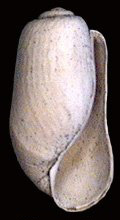Retusidae
| Retusidae | ||||||||||||
|---|---|---|---|---|---|---|---|---|---|---|---|---|

Housing of Retusa obtusa |
||||||||||||
| Systematics | ||||||||||||
|
||||||||||||
| Scientific name | ||||||||||||
| Retusidae | ||||||||||||
| Thiele , 1925 |
The Retusidae are a family of exclusively marine snails in the order of the head shield snails (Cephalaspidea). The small hind gill snails that are widespread worldwide have an outer shell. They feed primarily on small animals such as foraminifera .
features
The thin-walled, mostly no more than 6 mm long snail shells of the Retusidae are pear-shaped, elongated, cylindrical or pointed towards the rear, but mostly blunt and have a long housing mouth that widens towards the head of the snail. The protoconch can be sunken, short and teat-shaped or pointed. The surface of the bowl, which has several whorls, is usually smooth, but there may be a slight axial or spiral sculpting or both. The snails can retreat completely into their shell, but most species do not have an operculum to close the mouth.
The head shield of the Retusidae has a pair of rounded or pointed antennae on the back, which often cover the front end of the shell. The coat does not protrude noticeably. The snails have neither radula nor jaws, in which they differ from the very similar Cylichnidae . There is a chewing stomach with chewing plates, unlike the genus Rhizorus, which used to belong to this family .
Occurrence and distribution
The approximately 80 species in the 6 genera of the Retusidae occur in seas worldwide, from the intertidal zone and shallow bays to depths of over 5000 m.
The snails of the Retusidae feed primarily on foraminifera , but also on very small molluscs ( Watt snails ) and diatoms .
As far as is known, snails in the Retusidae family are first males and then females ( protandric hermaphroditism ) with internal fertilization. At least in some of the species there is a direct development in which finished snails hatch from the egg capsules without a previous swimming larval stage, such as Retusa obtusa .
Systematics
According to Bouchet and Rocroi (2005), the Retusidae family is one of eight families in the Philinoidea superfamily . The family includes six genera:
- Cylichnina Monterosato, 1884
- Pyrunculus Pilsbry, 1895
- Relichna Rudman, 1971
- Retusa T. Brown, 1827
- Sulcoretusa J.Q. Burch, 1945
- Volvulopsis Schepman , 1913
literature
- John W. Tunnell, Jean Andrews, Noe C Barrera, Fabio Moretzsohn: Encyclopedia of Texas Seashells: Identification, Ecology, Distribution, and History . Texas A&M University Press, College Station (Texas) 2010. 512 pp. Retusidae : p. 281.
- Robert Tucker Abbott, Percy A. Morris: A Field Guide to Shells: Atlantic and Gulf Coasts and the West Indies . Houghton Mifflin Harcourt, 2001. Retusidae : p. 269. ISBN 978-0-618-16439-4 .
- John D. Fish, Susan Fish: A Student's Guide to the Seashore . Cambridge University Press, Cambridge 2011. 540 pages. Retusidae. Retusa obtusa (Montagu), Pearl bubble : p. 238.
- Philippe Bouchet & Jean-Pierre Rocroi: Part 2. Working classification of the Gastropoda . Malacologia, 47: 239-283, Ann Arbor 2005 ISSN 0076-2997
- Winston Ponder & David Lindberg, Towards a phylogeny of gastropod molluscs; an analysis using morphological characters . Zoological Journal of the Linnean Society, 119: 83-265, London 1997 ISSN 0024-4082
Individual evidence
- ^ A b S. Tyrell Smith: The ecology and life history of Retusa obtusa (Montagu) (Gastropoda, Opisthobranchia). In: Canadian Journal of Zoology. 45, 1967, pp. 397-405, doi : 10.1139 / z67-051 .
- ^ World Register of Marine Species , World Marine Mollusca database: Retusidae Thiele, 1925